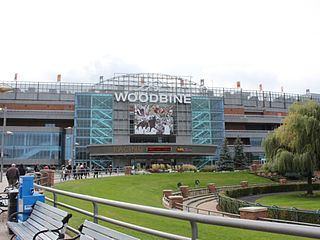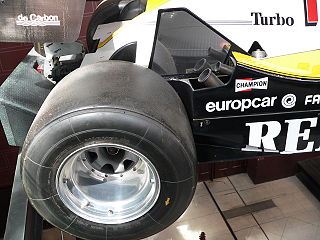
A race track is a facility built for racing of vehicles, athletes, or animals. A race track also may feature grandstands or concourses. Race tracks are also used in the study of animal locomotion.
Santa Anita Park is a Thoroughbred racetrack in Arcadia, California, United States. It offers some of the prominent horse racing events in the United States during early fall, winter and in spring. The track is home to numerous prestigious races including both the Santa Anita Derby and the Santa Anita Handicap as well as hosting the Breeders' Cup in 1986, 1993, 2003, 2008, 2009, 2012, 2013, 2014, 2016, 2019, and 2023. Since 2011, the Stronach Group are the current owners.

Woodbine Racetrack is a race track for Thoroughbred horse racing in the Etobicoke area of Toronto, Ontario, Canada. Owned by Woodbine Entertainment Group, Woodbine Racetrack manages and hosts Canada's most famous race, the King's Plate. The track was opened in 1956 with a one-mile oval dirt track, as well as a seven-eights turf course. It has been extensively remodeled since 1993, and since 1994 has had three racecourses.

A racing slick or slick tyre is a type of tyre that has a smooth tread used mostly in auto racing. The first production slick tyre was developed by M&H Tires in the early 1950s for use in drag racing. By eliminating any grooves cut into the tread, such tyres provide the largest possible contact patch to the road, and maximize dry traction for any given tyre dimension; see Performance. Slick tyres are used on race tracks and in road racing, where acceleration, steering and braking require maximum traction from each wheel. Slick tyres are typically used on only the driven (powered) wheels in drag racing, where the only concern is maximum traction to put power to the ground, and are not used in rallying.
The Australian and New Zealand punting glossary explains some of the terms, jargon and slang which are commonly used and heard on Australian and New Zealand racecourses, in TABs, on radio, and in the horse racing media. Some terms are peculiar to Australia, such as references to bookmakers, but most are used in both countries.
Kentucky Downs is a Thoroughbred horse racing track located on the border between Kentucky and Tennessee, in the city of Franklin, Kentucky, just off Interstate 65. It is unique among American tracks in that it is a European-style course—its surface is all turf (grass) instead of dirt, and it is not oval in shape.
Hawthorne Race Course is a racetrack for horse racing in Stickney/Cicero, Illinois, near Chicago.
A graded stakes race is a thoroughbred horse race in the United States that meets the criteria of the American Graded Stakes Committee of the Thoroughbred Owners and Breeders Association (TOBA). A specific grade level is then assigned to the race, based on statistical analysis of the quality of the field in previous years, provided the race meets the minimum purse criteria for the grade in question. In Canada, a similar grading system is maintained by the Jockey Club of Canada. Graded stakes races are similar to Group races in Europe but the grading is more dynamic in North America.

Rain tires or wet tires are special tyres used in motorsport in wet weather as opposed to a slick tyre used in dry conditions. They are very similar in many ways to the tyres found on normal road cars.
The Beyer Speed Figure is a system for rating the performance of Thoroughbred racehorses in North America designed in the early 1970s by Andrew Beyer, the syndicated horse racing columnist for The Washington Post. First published in book form in 1975, the Daily Racing Form began incorporating Beyer Speed Figures in a horse's past performances in 1992 and the system now assigns a Beyer number for each horse race. On the Beyer scale, the top stakes horses in the United States and Canada typically earn numbers in the 100s, while extremely strong performances can rate in the 120s. In Europe, Timeform has a similar rating scale that yields a number, but with a different value. The popular rule of thumb for a rough equivalent of the Timeform score is to deduct 12-14 points to achieve the Beyer figure. For American Quarter Horse racing, the Speed index rating system is used.
Layered clothing is a fashion technique that is utilized by dressing many garments that are worn on top of each other. Flexible clothing can be worn to suit the requirements of each situation by adding or removing layers, or by changing one layer and leaving the others. Two thin layers can be warmer yet lighter than one thick layer, because the air trapped between layers serves as thermal insulation.
A penetrometer is a device to test the strength of a material.
Racehorse injuries and fatalities are a side effect of training and competition. The problem with equine injuries is that they so often result in death. A 2005 study by the United States Department of Agriculture found that injuries are the second leading cause of death in horses, second only to old age. Nureyev's recovery from a broken leg while retired at stud in 1987 typifies the struggle horses have after being injured.
The 2011 Tums Fast Relief 500 was a NASCAR Sprint Cup Series stock car race held on October 30, 2011, at Martinsville Speedway in Ridgeway, Virginia, United States. Contested over 500 laps on the 0.526-mile (847 m) oval, it was the 33rd race of the 2011 Sprint Cup Series season, as well as the seventh race in the ten-race Chase for the Sprint Cup, which ends the season. The race was won by Tony Stewart for the Stewart Haas Racing team. Jimmie Johnson finished second, and Jeff Gordon clinched third.
Glossary of North American horse racing:
The track surface of a horse racing track refers to the material of which the track is made. There are three types of track surfaces used in modern horse racing. These are:

The 2015 Breeders' Cup World Championships was the 32nd edition of the thoroughbred horse racing season-ending premier event held on October 30 and 31 at Keeneland in Lexington, Kentucky. The race series, held for the first time at Keeneland, required a significant amount of preparation to transform the small, historic track into a venue capable of handling large crowds, comprising 13 championship races held over a two-day period.

A handicap race in horse racing is a race in which horses carry different weights, allocated by the handicapper. A better horse will carry a heavier weight, to give it a disadvantage when racing against slower horses.
Win (1980-2002) was an American Thoroughbred racehorse purchased for $8,000 as a two-year-old that would retire from racing having earned more than $1.4 million.






